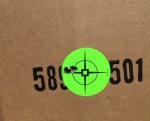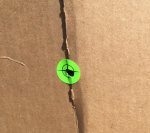Here is another evaluation of the 5-27... I have had it since they were first released. I have enough time with it to feel comfortable with my comments.
I have now had the opportunity to use the 5-27 with MPCT1 reticle to shoot in 4 matches for a total of 7 days behind the optic during competitions. I have also used it for many practice sessions, load development and my 10 year old used it to shoot to a mile in a side match. To date I have just short of 1700K rounds under it.
My wife has about 400 with hers. She has an MPCT2.
The 3 areas that are the most important to me are:
- Repeatability and exactness of adjustments for both elevation and wind
- Depth of parallax and the ease of eye-box, forgiveness and ability to have a clear full sight picture without perfect head position. .
- Reticle
The next 2 areas are very subjective:
4. Smoothness, feel of the turrets
5 Glass, image quality
Repeatability: Thus far it is perfect. I have done a tall target test to 10 mils and the adjustment are correct. I did a measured box test and the reticle marks match the turret adjustments. In actual use on paper out to 1K yards, the adjustments have been consistent and correct. When making a .1 to .2 mil adjustment to verify loads, the impacts on paper have been within the adjustment range and the rifles ability for consistency.
Shooting on paper at 600 yards, the small adjustments have been exact. Under field conditions on steel, the adjustments have been correct and repeatable. When we make .2 to .5 dial adjustments at 1300 yards, the impacts track with those adjustments.
At 1745 yards, the feed back from spotters indicated the .3 and .5 wind corrects were correct. There were between 19.3 mils of elevation dialed. We had plenty of adjustments to keep the 260 dialed at that range. (Gwen, 10 year old daughter was 1 of 5 shooters to successfully make a hit at that range) The first shot was within .3 mils of elevation. We had not previously shot the scope to that range.
I am very pleased with the adjustments. They are spot on and repeatable.
Depth of parallax: This is a huge issue to both my wife and I. I like to set the parallax at a midpoint for a string of mid to longer range targets and forget it. Truth is I usually set it on the first target and forget it unless the last targets are over 800…
I have been very pleased. I have not noticed any parallax to date on the mid targets and have shot to 960 with a the settings at 300 and not had an issue. The resolution of the targets remains good as well when looking at target image at different distances with a shorter range adjusted parallax. The knob is smooth and not binding, but it does not rotate on its own. It is also large enough I am not searching for it or cussing how stiff it is.
The “eyebox” ease is great. If the eye relief is adjusted for the shooter, I have been very pleased with the image throughout the adjustment range. Granted, things get tighter at the high mag, but when the head position has the greatest chance of not being perfect, we are usually at 12 to 18 range in the power settings and the image does not black out or partially black out under normal conditions.
I believe a great testament to the generous eye relief and “eyebox” was with my daughter at the mile shoot. She used my rifle with an LOP over 14 inches ( she usually is at 12.75 inches). She likes to crank the scope up and she had zero issues maintaining a clear, full sight picture and no parallax issues…
Anne’s scope: She says adjustment is very short on th pplx. The mid to longer range adjustments are only an 1/8 turn or so. .
Turrets:
To date this seems to be the sticky spot on the optic. I have the early model with the softer elevation and much firmer, tactile windage.
Honestly, I did not like the elevation feel to begin with, but after use and the days of match shooting, I am sold. I like the speed, ease of adjustment and the solid, yet “soft” feel. I have not mis-dialed due to the feel of the turret.
My wife has a newer model and It is sharp and stiff. The feel and to some extent the sound is distinct and positive.
The wind is solid and feels good, but in reality, I had to watch it when making small adjustments because of the force needed to make the initial movement and at times I would over adjust because of the needed force.
The size of the turrets is great. Large and easy to grab even when wearing gloves.
Note: I have shot this from 0 to 97 degrees. Shot a match in the snow at 25.... There is no difference from the temp in the feel of the turrets, but they do work well with gloves..

My only negative comment is the same as I have discussed many times…. I wish they had 10 mils per revolution to increase the spacing so those of us with older eyes can more clearly see where we are. I do not like the tight spacing and smallish indicator line. The large primary numbers are fantastic, I would like more space and larger lines in between…
Reticle: Fantastic. I thought it would be too fine in the 10 to 12 range, but I was incorrect. I have not had an issue picking up my holds even at those power settings. The .4 and .6 tall lines are the primary selling point to me. They are fast references and are my primary mover holds. They make fast and follow up shots on movers simple and quick.
My wife has been very pleased with the MPCT2. She has held off a couple of times and likes the layout. She is very pleased with the open area around the 1 mil lines. She can see impacts and call corrections very rapidly.
Glass: Fantastic. 2 points:
1. I have been able to see 30 cal holes at 600 on white paper with good lighting conditions..
2 Huge mirage at a recent match. I was able to use more power than most and able to “see through it”. I like the ability to read mirage with the optic on marginal mirage locations/days as well.
Always nice to be able to clearly resolve impacts on steel at 1300 yards in good conditions. Seeing impacts on white or tan steel at 1K and in is not an issue.
I did notice a touch of color fringing in extremely bright conditions, but it is not an issue, just a comment.
I am currently waiting for a 4-20…





